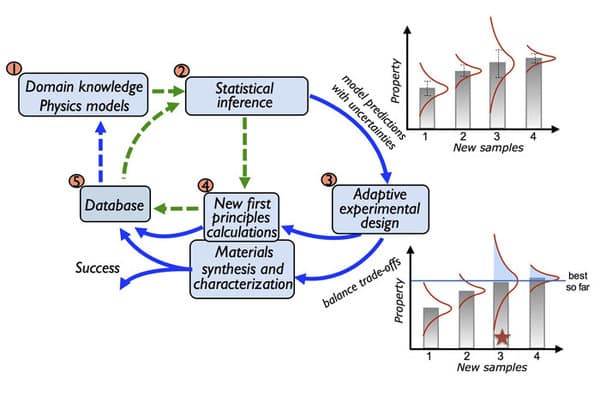Machine Learning To Enhance The Process Of Discovering New Materials Bearing Suitable Properties
Machine learning could be soon readily used for monitoring manufacturing procedures of new materials, as reported by the Los Alamos National Laboratory. A unique computer based technique might provide a breather to the hectic effort required during customization of a target material. A group of researchers have experimentally proven that an integrated informatics-based adaptive design could repetitively work as a catalyst for a system which generates these inexistent materials as per requirement.
A well fed and controlled system could meet the demands depending upon a small set of previously optimized experiments. Turab Lookman, a physicist and material scientist who is also the lead author of the current project stated that this novel approach was itself an innovation and it would significantly ease the initial steps for devising a material. Methods involving Trial and error or intuition were rather vague and impractical as the combination grows, whereas their research output is thoroughly scientific and certain.

Adaptive Design Framework
The team put in an effort to embed machine learning in their searching procedure and it was able to fit in the space as expected. They developed a structure which succeeded in driving upcoming experiments concerning shape-memory alloy with very low thermal hysteresis, using the inherent uncertainty prevailing in the quantum world. The demonstrated system makes use of recorded data and in turn provides impeccable results as far as reliability, cost effectiveness and time-saving approaches are concerned.
The complete work is allocated under the control of Los Alamos' state-of-the-art supercomputing resources. The primary work load is associated with screening databases with the help of quantum mechanical approaches, however it is currently not prepared to handle systems filled with defects and other complex notions such as solid solutions, non-stoichiometry and multi-component compounds.
Although this method has been devised for this particular experiment, it could be altered in other sectors which demand similar calculations. The project was funded by the LDRD program of the same university and was published in the Nature Communications Journal.
Source: #-Link-Snipped-# | #-Link-Snipped-#
A well fed and controlled system could meet the demands depending upon a small set of previously optimized experiments. Turab Lookman, a physicist and material scientist who is also the lead author of the current project stated that this novel approach was itself an innovation and it would significantly ease the initial steps for devising a material. Methods involving Trial and error or intuition were rather vague and impractical as the combination grows, whereas their research output is thoroughly scientific and certain.

Adaptive Design Framework
The complete work is allocated under the control of Los Alamos' state-of-the-art supercomputing resources. The primary work load is associated with screening databases with the help of quantum mechanical approaches, however it is currently not prepared to handle systems filled with defects and other complex notions such as solid solutions, non-stoichiometry and multi-component compounds.
Although this method has been devised for this particular experiment, it could be altered in other sectors which demand similar calculations. The project was funded by the LDRD program of the same university and was published in the Nature Communications Journal.
Source: #-Link-Snipped-# | #-Link-Snipped-#
0
